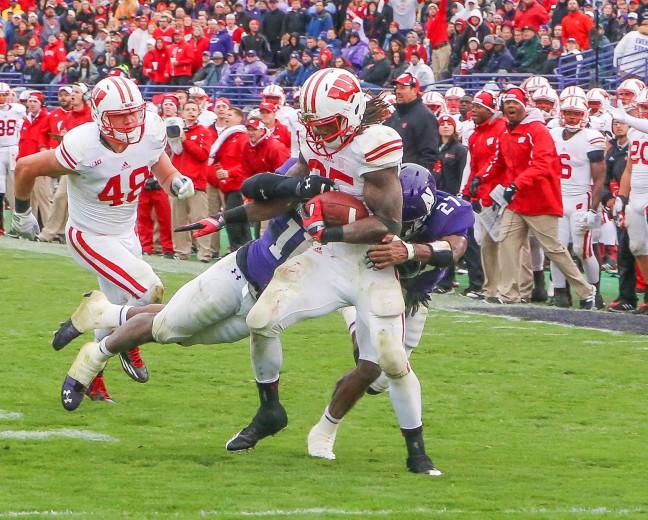EVANSTON, Illinois – Melvin Gordon rushed for a career-high 259 yards Saturday afternoon, but the hidden problems of the Wisconsin football team’s offense resurfaced in an alarming way in a 20-14 loss at Northwestern.
The Badgers (3-2 overall, 0-1 Big Ten) had several bad breaks including two injuries on defense and a big offensive change with the swapping of Joel Stave for starter Tanner McEvoy at quarterback.
However, Gordon did not use those excuses to explain Wisconsin’s failure to capitalize on multiple opportunities.
“We had position changes with the quarterback; we had some guys get banged up on defense. It’s tough having to adjust and change to that. Somehow you just got to find it deep inside you to make those plays and we didn’t,” Gordon said.
After a loss to start the season against LSU in which McEvoy threw for just 50 yards with two interceptions, the offense covered the issues exposed in the season-opening defeat with a big day of passing from McEvoy against Western Illinois followed by two big games on the ground against Bowling Green and South Florida.
But despite 425 yards of total offense against the Wildcats (3-2, 2-0), the Badgers’ offense struggled to perform consistently over the four quarters and revealed that the apparent fixes over the last several weeks were merely cosmetic.
“We have not proven effective enough to be what I would call a stable offense. I don’t care about yards. I don’t care about all the other stuff, other than a functioning offense that allows us to win Big Ten games,” head coach Gary Andersen said.
A great bulk of UW’s offensive problems this year have revolved around a passing game that, outside of the game against Western Illinois, has been average at best. Outside of the 50 yards from McEvoy in week one, the passing attack has had passing totals of 112 yards against BG, 160 yards against USF and 138 yards Saturday, with 289 yards against Western Illinois, the lone outlier.
But besides a sheer lack of a passing game, the Badgers’ have also had turnovers factor into the offensive struggles. Luckily, the four interceptions before Saturday hadn’t hurt UW too much, but the four interceptions against Northwestern ultimately turned the game in the Wildcats’ favor.
More glaring than the four interceptions was the fact that two of them came within the red zone. The first occurred with Wisconsin on a strong opening drive, looking like it would score the first points of the game. But backed up into a 3rd-and-11 on the Northwestern 20, McEvoy floated a jump ball that got picked off by Godwin Igwebuike to end the drive.
McEvoy played the next three drives, but with the Wisconsin offense sputtering, he got replaced by Stave on the last drive of the first half.
Stave orchestrated a scoring drive, mostly due to the rushing prowess of Gordon, on the first possession of the second half, but he went on to throw three interceptions of his own.
“You can’t get down in the red zone and not come away with points. That’s basically where we’re at right now. We’ve got to make sure that consistently we’re playing good offense,” Stave said.
Wisconsin finished just 2-5 on its red zone trips, with the most glaring missed opportunity coming with less than six minutes left in the game. Trailing by 13, UW had a first and goal at the Wildcats’ three but opted for play action instead of a run. Stave rolled to his right and tried to fit a pass into tight quarters while under pressure near the sideline, trying to find Alex Erickson. Igwebuike, who had three interceptions, picked the ball off again and essentially sealed the loss.
The passing game struggles from Saturday didn’t pertain to solely the quarterbacks, as the loss of Jared Abbrederis from last year was again magnified. With Stave in the game, UW tried several long throws but couldn’t complete any.
Although the deep throws from Stave weren’t perfect, the Badgers didn’t have a proven downfield threat to target in any of those situations.
“A year ago, we throw that thing up there and there’s a pretty special kid going up and getting it,” Andersen said in reference to Abbrederis. “The kids that are playing right now want to be special but they got to get better at it.”
Wisconsin’s longest pass against Northwestern was 24 yards from Stave to tight end Sam Arneson, who Andersen called UW’s number one receiving threat at this point. The longest pass of the season is still only 37 yards, strong evidence of Wisconsin’s inability to throw the ball downfield or have a receiver capable of making those catches.
Meanwhile, Gordon continued to showcase his dominance after his disappointing performance in game two when he had just 38 net yards rushing against Western Illinois. He accumulated a career-high with his 259 yards against Northwestern, but managed just one touchdown. A lot of that had to do with Gordon’s seven-total red zone carries, four of which came on the scoring drive to open the second half.
Wisconsin’s frustrations in the red zone also had some roots in sloppy play by the offensive line that resulted in several crucial penalties, and a lack of protection for both quarterbacks at times.
Although the quarterbacks have been the noticeable weakness for Wisconsin this season, as they were again Saturday, the offensive unit as a whole has some large deficiencies to fix just one game into the Big Ten season.
“Right now, we’ve got to look and see what’s the functionality of our offense, what is absolutely the best offense that fits our offensive line, our wide receivers, the tight ends, fullbacks and everybody that’s involved,” Andersen said.


